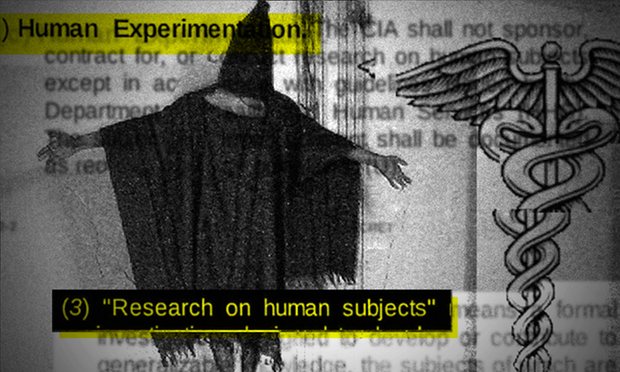 2004: Abu Ghraib: photographic evidence of U.S. torture of prisoners of war
2004: Abu Ghraib: photographic evidence of U.S. torture of prisoners of war
In 2004, public attention was drawn to the Abu Ghraib prison in Iraq because of the graphic photographs documenting depraved sadistic cruelty. The photographs had been taken by soldiers who participated or witnessed the dehumanizing criminal abuse; the photographs are incriminating evidence validating long denied allegations of physical, psychological, and sexual abuse that meet the definition of torture. Rape, sodomy, and homicide have also been alleged. The abominable, inhumane, criminal actions recorded in the photographs were performed by low ranking military personnel who posed for the photographs that were widely disseminated on the internet. Many of the soldiers claimed that the abuse was authorized by their superiors, attempting to shift the blame away from themselves.
“Placing hoods over the heads of political prisoners—a modified form of sensory deprivation—has become a standard torture tactic around the world; it was developed by the CIA… The Abu Ghraib [and Guantanamo] torture scandal is the product of a deeply contradictory U.S. policy toward torture since the start of the Cold War…Upon careful examination, those photographs of nude bodies expose the CIA’s most basic torture techniques – stress positions, sensory deprivation, and sexual humiliation.”
(Alfred McCoy, A Question of Torture: CIA Interrogation, From the Cold War to the War on Terror, 2006; Hidden History of CIA Torture: America’s Road to Abu Ghraib, 2004)
CIA Inspector General Report confirmed that Abu Ghraib was not an isolated incident
In January 2003, the CIA Inspector General initiated an investigation to CIA interrogation practices. It’s Top Secret Report, “Counterterrorism Detention and Interrogation (Sept. 2001 – Oct. 2003) issued May 7, 2004, is devastating critique of the agency’s detention and interrogation activities. The report raises doubts about the efficacy, ethics and legality of CIA’s harsh methods which it notes, are expressly forbidden and banned by federal law. Read more… here
Previously classified documents confirm that since 2001, medical and scientific personnel have played a role, largely hidden, in helping to design and monitor interrogations that are intended to exploit the physical and mental vulnerabilities of detainees. Read how American Doctors & psychologists devised, tested& calibrated torture techniques to maximize pain.
 “It was doctors who devised the rectal infusions “as a means of behavior control.” “…you get a tube up as far as you can, then open the IV wide. No need to squeeze the bag — let gravity do the work.” (p. 100) “Doctors found prisoners with broken feet and still approved putting them into standing positions for up to 52 hours. Medical officers also advised the CIA on the water temperatures for waterboarding detainees after sleep deprivation.”(Senate Select Intelligence Committee Executive Summary (2014): p. 112)
“It was doctors who devised the rectal infusions “as a means of behavior control.” “…you get a tube up as far as you can, then open the IV wide. No need to squeeze the bag — let gravity do the work.” (p. 100) “Doctors found prisoners with broken feet and still approved putting them into standing positions for up to 52 hours. Medical officers also advised the CIA on the water temperatures for waterboarding detainees after sleep deprivation.”(Senate Select Intelligence Committee Executive Summary (2014): p. 112)
The real goal of the government’s torture program was inducing learned helplessness — the breakdown of human will — rather than gathering intelligence information. This was confirmed by the U.S. Justice Department Report: Investigation into the Office of Legal Counsel’s Memoranda, 2009.
“For the first time in its history, the United States sanctioned government officials to physically and psychologically torment U.S.-held captives, making torture the official law of the land in all but name.” Jane Mayer. The Dark Side: The Inside Story of How the War on Terror Turned into a War on American Ideals, 2008
Read Guantanamo America’s Battle Lab. Seton Hall Law Center for Policy and Research, 2015; read AHRP’s extensive documented section, Torture Experiments.
The Experiment by Jan Mayer, The New Yorker, July, 2005
“The strange accounts of torment that have steadily emerged [ …] are connected to decades of research by American scientists into the psychological nature of warfare and captivity. The research, which began during the Cold War, developed new currency after September 11th, when the Bush Administration declared a global war on terror and began trying to extract intelligence from radical Islamists, many of whom have been trained not to reveal anything about their activities.”
Since 2001, medical and scientific personnel have played a largely covert role helping to design and monitor interrogations that are intended to exploit the physical and mental vulnerabilities of detainees. According to a former interrogator at Guantánamo who was interviewed at length by a lawyer, “behavioral scientists control the most minute details of interrogations, to the point of decreeing, in the case of one detainee, that he would be given seven squares of toilet paper per day.”
“It is both illegal and deeply unethical to use techniques that profoundly disrupt someone’s personality,” Leonard S. Rubenstein, the executive director of Physicians for Human Rights, an advocacy group that has been critical of the Bush Administration, says. “But that’s precisely what interrogators are doing, in order to try to get people to talk.”
“These psychological gambits are obviously not isolated events. They’re prevalent and systematic. They’re tried, measured, and charted. These are ways to humiliate and disorient the detainees. The whole place appears to be one giant human experiment.” Baher Azmy, a professor at Seton Hall Law School, in Newark, NJ.
Mayer interviewed Dr. Darryl Matthews, a psychiatrist whom the Army brought in as a consultant after many suicide attempts at Guantánamo, and who has since become a critic of conditions at the prison camp, stated:
“As psychiatrists, we know how to hurt people better than others. We can figure out what buttons to push. Like a surgeon with a scalpel, we have techniques and we know what the pressure points are.”
 And she quotes Elena Nightingale, MD, a pediatrician and the co-editor of a 1985 anthology of essays about doctors and torture, “The Breaking of Bodies and Minds.” Dr. Nightingale notes that medical experts are often called on to assist with torture, because
And she quotes Elena Nightingale, MD, a pediatrician and the co-editor of a 1985 anthology of essays about doctors and torture, “The Breaking of Bodies and Minds.” Dr. Nightingale notes that medical experts are often called on to assist with torture, because
“people trust and confide in them, which is useful to torturers, and because they have the know-how to keep a person under torture alive, so that more information can be extracted.”
2005: American Psychological Association Task Force OKs assisting military interrogations
The APA task force ruled that psychologists could assist military interrogations to help make these “safe, legal and effective.” The APA task force also determined that, in cases where international human-rights law conflicts with U.S. law, psychologists could defer to the much looser U.S. standards—what psychologist Jean Maria Arrigo called the “Rumsfeld definition” of humane treatment. Given that 6 of 10 members of the task force had ties to the armed services and that the designated observers had undisclosed conflicts of interest, it’s safe to say, the APA task force was rigged. Read. Pay Any Price: Greed, Power, and Endless War (2014) by James Risen
Evidence has been uncovered showing that the APA had given its stamp of approval to participation in military interrogations as part of a quid pro quo. The suspicion is that the Pentagon was working to allow psychologists to prescribe medication – thereby dramatically increasing psychologists’ income. Read more here and here.
The Justice Department, in contravention of all national and international norms, has repeatedly blocked attempts by prisoners’ lawyers to obtain copies of detainees’ medical records.


